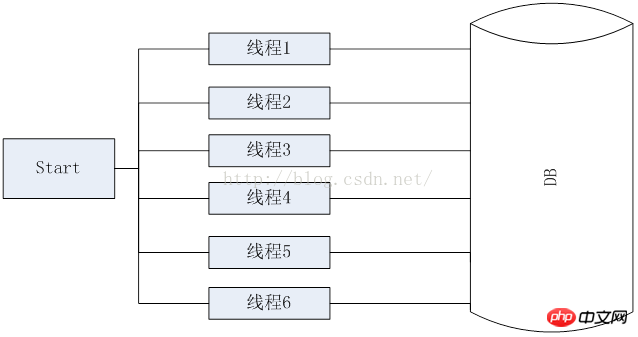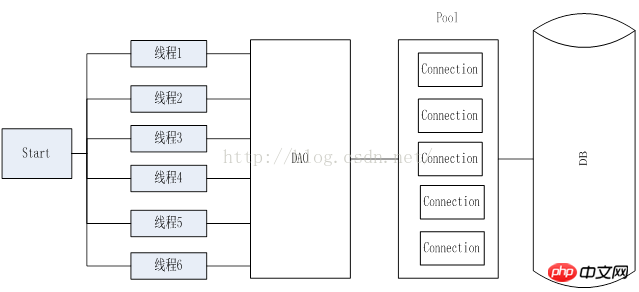 Database
Database
 Mysql Tutorial
Mysql Tutorial
 Tomcat-dbcp database connection pool configuration and some pitfalls when using it
Tomcat-dbcp database connection pool configuration and some pitfalls when using it
Tomcat-dbcp database connection pool configuration and some pitfalls when using it
1. Database connection pool
When developing, you often need to perform some operations on the database, such as common additions, deletions, modifications, and searches. When the amount of data is small, It can be operated directly, but when the amount of data increases, each connection and release of the database will take a certain amount of time. At this time, the database connection pool can be used to maintain the database link and reduce the overhead caused by connecting to the database on the program, and It can reduce the pressure on the database, so what is the database connection pool? As the name suggests, it is a pond. What is placed in the pond is a link to the database. For example, a fish pond is a pond for raising fish. If you want to eat fish, you can directly fish it. You don’t have to buy fry and raise fish yourself. The database The connection pool is used to store links to the database. All links are established uniformly. When used, you can directly take them from it. After use, you can put them back into the pool. Since you use this thing, then We don’t need to write the code ourselves. Some open source ones can be used directly. There are three common open source connection pools, c3p0, dbcp, and proxool. I have never used c3p0 and proxool, just simple I have used dbcp pool, here I will talk about how to use dbcp database connection pool, and some pitfalls encountered when using it

Figure 1, before using connection pool

Figure 2 After using the connection pool
As shown in Figure 1 above, before using the connection pool, you need to A link is established to the database every time and needs to be released at any time. When the amount of data is large, it requires a lot of overhead to connect to the database, and frequent access and release of the database will also put a lot of pressure on the database. , Figure 2 shows that after using the database connection pool, all links are placed in the pool without releasing them. When used, they are taken directly from the pool and put back into the pool after use. The pool maintains long links to the database. If the link is disconnected, it will automatically reconnect. If the connection is not enough, subsequent users will need to wait.
2. Use the jar package used by tomcat-dbcp
contains tomcat-dbcp.jar That’s it, the rest are some basic packages
3. Configuration used
dbname.Driver=com.mysql.jdbc.Driver dbname.Url=jdbc:mysql://<your ip>/<your dbname>?useUnicode=true&characterEncoding=UTF-8 &autoReconnect=true&failOverReadOnly=false&maxReconnects=10&autoReconnectForPools=true&zeroDateTimeBehavior=convertToNull&connectTimeout=3000 dbname.Username=<your username> dbname.Password=<your password> dbname.InitialSize=15 dbname.MinIdle=10 dbname.MaxIdle=20 dbname.MaxWait=5000 dbname.MaxActive=20 dbname.validationQuery=select 1
These configurations only need to be placed in
where driver, url, username, and password are common database connection configurations
InitialSize为初始化建立的连接数
minidle为数据库连接池中保持的最少的空闲的链接数
maxidle数据库连接池中保持的最大的连接数
maxwait等待数据库连接池分配连接的最长时间,超出之后报错
maxactivite最大的活动链接数,如果是多线程可以设置为超出多线程个数个链接数
<pre name="code" class="java">validationQuery测试是否连接是有效的sql语句
3. Connection pool code
public abstract class DB {
private static HashMap<String, DataSource> dsTable = new HashMap<String, DataSource>();//此处记得用static
private BasicDataSource ds;
private PreparedStatement stmt = null;
private DataSource getDataSource(String n) {
if (dsTable.containsKey(n)) {
return dsTable.get(n);//如果不同的数据库,多个连接池
} else {
synchronized (dsTable) {
ds = new BasicDataSource();
ds.setDriverClassName(DBConfig.getString("db", n.concat(".Driver")));//将<yourname>.properties的值读进来
ds.setUrl(DBConfig.getString("db", n.concat(".Url")));
ds.setUsername(DBConfig.getString("db", n.concat(".Username")));
ds.setPassword(DBConfig.getString("db", n.concat(".Password")));
ds.setInitialSize(DBConfig.getInteger("db", n.concat(".InitialSize")));
ds.setMinIdle(DBConfig.getInteger("db", n.concat(".MinIdle")));
ds.setMaxIdle(DBConfig.getInteger("db", n.concat(".MaxIdle")));
ds.setMaxWait(DBConfig.getInteger("db", n.concat(".MaxWait")));
ds.setMaxActive(DBConfig.getInteger("db", n.concat(".MaxActive")));
ds.setValidationQuery(DBConfig.getString("db", n.concat(".validationQuery")));
dsTable.put(n, ds);
return ds;
}
}
}
protected Connection conn;
public boolean open() throws SQLException {
BasicDataSource bds=(BasicDataSource)this.getDataSource(this.getConnectionName());
System.out.println("connection_number:"+bds.getNumActive()+"dsTable:"+dsTable);
this.conn = this.getDataSource(this.getConnectionName()).getConnection();
return true;
}
public void close() throws SQLException {
if (this.conn != null)
this.conn.close();
}
protected abstract String getConnectionName();//此函数可以根据自己的需求,将数据库的名字传进来即可
public void prepareStatement(String sql) throws SQLException {
this.stmt = this.conn.prepareStatement(sql);
}
public void setObject(int index, Object value, int type) throws SQLException {
this.stmt.setObject(index, value, type);
}
public void setObject(int index, Object value) throws SQLException {
this.stmt.setObject(index, value);
}
public int execute() throws SQLException {
return this.stmt.executeUpdate();
}
}The above is the code used when using the thread pool. It only gives a rough writing method. The specific DBDAO part needs to be implemented by yourself according to your own needs, such as batch processing, query, and update. Functions such as these can be modified according to personal needs, so how do you judge whether the link you create is what you want? There are two ways to check
1. Create an empty database and check the number of links
2. Check the number of links under linux
Get the processid
ps aux|grep <your java name>
View the links to the database
netstat -apn|grep <your processid>
You can see the specific number of links to check whether your connection pool is correct
4. Some pitfalls encountered
Because it is used in multi-threaded form, the most important pitfall encountered is the usage of static. Because I am not too familiar with it, I don’t use static. , resulting in each thread establishing a database connection pool, and a "too many files open" error occurred. This was caused by the fact that static was not used in the thread pool.
The above is the tomcat-dbcp database connection pool configuration and some pitfalls when using it. For more related content, please pay attention to the PHP Chinese website (www.php.cn)!

Hot AI Tools

Undresser.AI Undress
AI-powered app for creating realistic nude photos

AI Clothes Remover
Online AI tool for removing clothes from photos.

Undress AI Tool
Undress images for free

Clothoff.io
AI clothes remover

Video Face Swap
Swap faces in any video effortlessly with our completely free AI face swap tool!

Hot Article

Hot Tools

Notepad++7.3.1
Easy-to-use and free code editor

SublimeText3 Chinese version
Chinese version, very easy to use

Zend Studio 13.0.1
Powerful PHP integrated development environment

Dreamweaver CS6
Visual web development tools

SublimeText3 Mac version
God-level code editing software (SublimeText3)

Hot Topics
 1386
1386
 52
52
 How does Go language implement the addition, deletion, modification and query operations of the database?
Mar 27, 2024 pm 09:39 PM
How does Go language implement the addition, deletion, modification and query operations of the database?
Mar 27, 2024 pm 09:39 PM
Go language is an efficient, concise and easy-to-learn programming language. It is favored by developers because of its advantages in concurrent programming and network programming. In actual development, database operations are an indispensable part. This article will introduce how to use Go language to implement database addition, deletion, modification and query operations. In Go language, we usually use third-party libraries to operate databases, such as commonly used sql packages, gorm, etc. Here we take the sql package as an example to introduce how to implement the addition, deletion, modification and query operations of the database. Assume we are using a MySQL database.
 iOS 18 adds a new 'Recovered' album function to retrieve lost or damaged photos
Jul 18, 2024 am 05:48 AM
iOS 18 adds a new 'Recovered' album function to retrieve lost or damaged photos
Jul 18, 2024 am 05:48 AM
Apple's latest releases of iOS18, iPadOS18 and macOS Sequoia systems have added an important feature to the Photos application, designed to help users easily recover photos and videos lost or damaged due to various reasons. The new feature introduces an album called "Recovered" in the Tools section of the Photos app that will automatically appear when a user has pictures or videos on their device that are not part of their photo library. The emergence of the "Recovered" album provides a solution for photos and videos lost due to database corruption, the camera application not saving to the photo library correctly, or a third-party application managing the photo library. Users only need a few simple steps
 How does Hibernate implement polymorphic mapping?
Apr 17, 2024 pm 12:09 PM
How does Hibernate implement polymorphic mapping?
Apr 17, 2024 pm 12:09 PM
Hibernate polymorphic mapping can map inherited classes to the database and provides the following mapping types: joined-subclass: Create a separate table for the subclass, including all columns of the parent class. table-per-class: Create a separate table for subclasses, containing only subclass-specific columns. union-subclass: similar to joined-subclass, but the parent class table unions all subclass columns.
 Detailed tutorial on establishing a database connection using MySQLi in PHP
Jun 04, 2024 pm 01:42 PM
Detailed tutorial on establishing a database connection using MySQLi in PHP
Jun 04, 2024 pm 01:42 PM
How to use MySQLi to establish a database connection in PHP: Include MySQLi extension (require_once) Create connection function (functionconnect_to_db) Call connection function ($conn=connect_to_db()) Execute query ($result=$conn->query()) Close connection ( $conn->close())
 How to handle database connection errors in PHP
Jun 05, 2024 pm 02:16 PM
How to handle database connection errors in PHP
Jun 05, 2024 pm 02:16 PM
To handle database connection errors in PHP, you can use the following steps: Use mysqli_connect_errno() to obtain the error code. Use mysqli_connect_error() to get the error message. By capturing and logging these error messages, database connection issues can be easily identified and resolved, ensuring the smooth running of your application.
 An in-depth analysis of how HTML reads the database
Apr 09, 2024 pm 12:36 PM
An in-depth analysis of how HTML reads the database
Apr 09, 2024 pm 12:36 PM
HTML cannot read the database directly, but it can be achieved through JavaScript and AJAX. The steps include establishing a database connection, sending a query, processing the response, and updating the page. This article provides a practical example of using JavaScript, AJAX and PHP to read data from a MySQL database, showing how to dynamically display query results in an HTML page. This example uses XMLHttpRequest to establish a database connection, send a query and process the response, thereby filling data into page elements and realizing the function of HTML reading the database.
 Tips and practices for handling Chinese garbled characters in databases with PHP
Mar 27, 2024 pm 05:21 PM
Tips and practices for handling Chinese garbled characters in databases with PHP
Mar 27, 2024 pm 05:21 PM
PHP is a back-end programming language widely used in website development. It has powerful database operation functions and is often used to interact with databases such as MySQL. However, due to the complexity of Chinese character encoding, problems often arise when dealing with Chinese garbled characters in the database. This article will introduce the skills and practices of PHP in handling Chinese garbled characters in databases, including common causes of garbled characters, solutions and specific code examples. Common reasons for garbled characters are incorrect database character set settings: the correct character set needs to be selected when creating the database, such as utf8 or u
 How to connect to remote database using Golang?
Jun 01, 2024 pm 08:31 PM
How to connect to remote database using Golang?
Jun 01, 2024 pm 08:31 PM
Through the Go standard library database/sql package, you can connect to remote databases such as MySQL, PostgreSQL or SQLite: create a connection string containing database connection information. Use the sql.Open() function to open a database connection. Perform database operations such as SQL queries and insert operations. Use defer to close the database connection to release resources.



